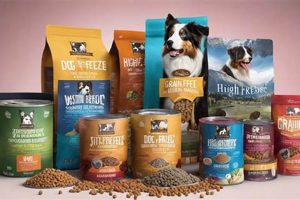Selecting optimal nourishment for Golden Retrievers involves discerning products formulated to meet the breed’s specific dietary requirements. These formulations prioritize ingredients and nutritional profiles that support overall health, factoring in the breed’s propensity for certain health conditions. An example would be a diet rich in omega-3 fatty acids to aid in joint health and maintain a healthy coat. Such diets often contain high-quality protein sources, moderate fat content, and limited fillers.
Providing suitable nutrition to Golden Retrievers is crucial for their well-being and longevity. Proper nourishment contributes to maintaining a healthy weight, supporting optimal joint function, and promoting a lustrous coat. Historically, owners have recognized the breed’s need for a balanced diet due to their active lifestyle and genetic predispositions. Supplying a diet deficient in key nutrients can lead to health issues, thereby emphasizing the importance of informed food choices.
The following sections will delve into specific ingredients to seek, potential allergens to avoid, and considerations for different life stages of Golden Retrievers. It will also explore the role of supplementation and methods for transitioning to a new diet, ensuring the long-term health and vitality of these canine companions.
Selecting Optimal Nourishment
Ensuring the well-being of Golden Retrievers hinges significantly on providing appropriate dietary choices. This section offers guidance on selecting nutrition that addresses the specific needs of the breed.
Tip 1: Prioritize Protein Sources: High-quality animal protein, such as chicken, lamb, or fish, should form the foundation of the diet. These protein sources provide essential amino acids crucial for muscle development and overall health.
Tip 2: Monitor Fat Content: A moderate fat content is necessary for energy and coat health, but excess fat can contribute to weight gain. Opt for formulas with healthy fats like omega-3 and omega-6 fatty acids, derived from fish oil or flaxseed.
Tip 3: Evaluate Carbohydrate Sources: Choose easily digestible carbohydrates such as brown rice, sweet potatoes, or oats. Avoid excessive amounts of fillers like corn, wheat, and soy, as these offer limited nutritional value and may trigger allergies.
Tip 4: Assess Life Stage Needs: Nutritional requirements vary based on age and activity level. Puppies require diets formulated for growth, while senior dogs benefit from formulas designed to support joint health and maintain muscle mass.
Tip 5: Consider Potential Allergens: Golden Retrievers are prone to certain allergies. Observe for any adverse reactions and consider hypoallergenic formulas if necessary. Common allergens include beef, dairy, and wheat.
Tip 6: Incorporate Joint Support Ingredients: Due to the breed’s susceptibility to hip and elbow dysplasia, select formulations containing glucosamine and chondroitin to support joint health.
Tip 7: Consult with a Veterinarian: Before making any significant dietary changes, consult with a veterinarian. They can provide personalized recommendations based on individual health needs and potential sensitivities.
By implementing these tips, owners can make informed decisions about the nourishment provided to Golden Retrievers. Selecting a diet tailored to their specific needs promotes optimal health, vitality, and longevity.
The concluding section will synthesize key points and offer actionable advice for maintaining the dietary well-being of Golden Retrievers.
1. Protein Source Quality
Protein source quality represents a cornerstone in the provision of superior nourishment for Golden Retrievers. It directly impacts muscle development, immune function, and overall physiological health, necessitating careful evaluation when selecting suitable food formulations.
- Amino Acid Profile Completeness
The presence of all essential amino acids in adequate proportions is critical. High-quality protein sources, such as chicken, fish, and lamb, inherently offer complete amino acid profiles that closely match the requirements of canines. Incomplete protein sources necessitate strategic supplementation to prevent deficiencies that can impair growth and immune response in Golden Retrievers.
- Digestibility and Bioavailability
The degree to which a protein source can be broken down and absorbed by the digestive system influences its nutritional value. Highly digestible proteins, commonly found in animal-based ingredients, facilitate efficient absorption of amino acids, maximizing their utilization for various bodily functions. Conversely, proteins from lower-quality sources, such as certain plant-based ingredients, may exhibit reduced digestibility, resulting in lower bioavailability and potentially leading to nutrient deficiencies.
- Source Purity and Processing Methods
The purity of the protein source and the processing methods employed significantly impact its quality. Contamination with additives or byproducts can compromise the protein’s integrity and potentially introduce harmful substances into the diet. Minimally processed protein sources, such as fresh meats, generally retain a higher nutritional value compared to heavily processed alternatives. Careful consideration of sourcing practices and processing techniques ensures the delivery of a safe and nutritious protein component.
- Impact on Satiety and Weight Management
The protein content and its digestibility contribute to the sensation of fullness after eating, assisting in weight management. Protein-rich diets can help maintain lean muscle mass while minimizing excessive calorie intake. This is especially relevant for Golden Retrievers, a breed predisposed to weight gain and associated health complications. Selecting high-quality protein sources can aid in regulating appetite and promoting a healthy body condition.
In summary, protein source quality directly correlates with the nutritional efficacy of diets formulated for Golden Retrievers. Prioritizing complete amino acid profiles, high digestibility, source purity, and considering the impact on satiety ensures that the dietary protein contributes optimally to their overall health and well-being, thereby supporting the goals of providing high quality nourishment.
2. Fatty Acid Balance
Fatty acid balance is an indispensable component of superior nourishment for Golden Retrievers. Its influence spans various physiological functions, including skin and coat health, inflammation regulation, and cognitive performance. A diet lacking appropriate ratios of omega-6 to omega-3 fatty acids can manifest as dermatological issues, heightened inflammatory responses, and potentially impaired cognitive function. For instance, an insufficient supply of omega-3 fatty acids, such as EPA and DHA found in fish oil, can exacerbate inflammatory conditions in the joints, a common concern within the breed. The inclusion of balanced fatty acids differentiates a product that is merely sufficient from one that genuinely supports long-term well-being.
In practice, ensuring the right fatty acid profile involves careful scrutiny of the ingredient list. The presence of fish oil, flaxseed, or other sources rich in omega-3 fatty acids alongside sources of omega-6, such as sunflower oil or poultry fat, is necessary. The ideal ratio, often cited as between 5:1 and 10:1 omega-6 to omega-3, supports optimal cellular function and inflammatory responses. However, excessive supplementation with either type can disrupt the balance, causing adverse effects. For example, disproportionately high levels of omega-6 fatty acids relative to omega-3 fatty acids can promote pro-inflammatory pathways, potentially undermining the intended benefits of the dietary formulation.
The integration of a balanced fatty acid profile in superior Golden Retriever nutrition necessitates informed selection of ingredients and precise formulation. While individual requirements may vary depending on age, activity level, and specific health conditions, adherence to established guidelines for omega-6 to omega-3 ratios contributes significantly to maintaining skin and coat health, mitigating inflammation, and supporting cognitive function throughout the dog’s life. Addressing this essential aspect of dietary composition directly impacts the overall quality and effectiveness of the nutritional regimen.
3. Joint Health Support
Joint health support is a critical consideration when formulating or selecting nourishment for Golden Retrievers, owing to the breed’s predisposition to conditions such as hip and elbow dysplasia, as well as osteoarthritis. Diets that prioritize joint health support proactively contribute to mobility, reduce inflammation, and improve overall quality of life.
- Chondroprotective Agents
Chondroprotective agents, including glucosamine and chondroitin sulfate, are common additives in formulations intended to support joint health. Glucosamine aids in the synthesis of glycosaminoglycans, key components of cartilage. Chondroitin sulfate inhibits enzymes that degrade cartilage. Studies suggest that these compounds may help slow the progression of osteoarthritis and alleviate associated discomfort. Their inclusion is particularly beneficial for breeds with a high incidence of joint disorders.
- Omega-3 Fatty Acids
Omega-3 fatty acids, specifically eicosapentaenoic acid (EPA) and docosahexaenoic acid (DHA), possess anti-inflammatory properties that can benefit joint health. These fatty acids modulate inflammatory pathways, reducing the production of pro-inflammatory cytokines within the joint. Fish oil is a rich source of EPA and DHA, and its supplementation is frequently recommended to manage joint pain and stiffness. Clinical trials have demonstrated that omega-3 fatty acid supplementation can improve mobility in dogs with osteoarthritis.
- Antioxidant Compounds
Antioxidant compounds, such as vitamin E and vitamin C, combat oxidative stress, a factor implicated in the pathogenesis of osteoarthritis. Oxidative stress contributes to cartilage degradation and inflammation within the joint. Antioxidants neutralize free radicals, mitigating their damaging effects and supporting overall joint integrity. These compounds are often included in balanced formulations to promote cellular health and reduce inflammation.
- Weight Management Considerations
Maintaining a healthy body weight is essential for minimizing stress on the joints. Excess weight exacerbates joint pain and accelerates cartilage degeneration. Controlled caloric intake and balanced macronutrient ratios are vital for achieving and maintaining an optimal body condition score. Diets formulated with moderate fat content and adequate protein levels can assist in weight management, thereby indirectly supporting joint health.
In conclusion, the provision of joint health support through dietary means necessitates a comprehensive approach, encompassing chondroprotective agents, omega-3 fatty acids, antioxidant compounds, and weight management strategies. Formulations that effectively integrate these elements contribute significantly to maintaining mobility and reducing discomfort in Golden Retrievers, enhancing their overall well-being and longevity. Prioritizing such formulations represents a proactive step in addressing the breed’s inherent susceptibility to joint-related ailments.
4. Digestibility Factors
Digestibility factors represent a pivotal aspect of high quality nourishment for Golden Retrievers. The efficiency with which a canine’s digestive system processes nutrients from food directly influences their bioavailability and the overall health of the animal. High quality formulations emphasize ingredients and processing methods that facilitate optimal digestion and nutrient absorption, minimizing the likelihood of gastrointestinal distress and maximizing the nutritional benefits derived from each meal. The correlation between ingredient digestibility and canine health is direct; poorly digestible ingredients can lead to nutrient deficiencies, even when the total nutrient content of the food appears adequate.
The practical significance of digestibility factors becomes evident when considering the common sensitivities observed in Golden Retrievers. For example, certain grains, such as corn and wheat, are less digestible for some individuals. The consumption of foods high in these ingredients can manifest as diarrhea, vomiting, and skin irritation. Similarly, protein sources from rendered by-products often exhibit lower digestibility compared to whole muscle meats. Therefore, formulations containing easily digestible ingredients like rice, oats, and identifiable meat sources, contribute to improved digestive health. Furthermore, processing techniques such as gentle cooking methods or the inclusion of digestive enzymes and prebiotics, further enhance digestibility and nutrient absorption.
Concluding, digestibility factors are inextricably linked to the provision of high quality nutrition for Golden Retrievers. Prioritizing highly digestible ingredients, minimizing the presence of common irritants, and incorporating digestive aids ensures that Golden Retrievers derive maximum benefit from their food. This approach minimizes digestive upset, supports optimal nutrient absorption, and contributes to overall health and well-being. Understanding and addressing these factors is paramount for responsible owners seeking to provide the best possible nutritional care.
5. Limited Allergen Exposure
Limited allergen exposure is a critical facet of high quality nourishment for Golden Retrievers, given the breed’s predisposition to various food sensitivities and allergies. Formulations that minimize common allergens contribute to reducing adverse reactions, promoting digestive health, and maintaining skin integrity.
- Identification of Common Allergens
Certain ingredients are frequently implicated in allergic reactions in Golden Retrievers. These include beef, dairy, wheat, soy, corn, and artificial additives. Identification and subsequent avoidance of these ingredients are paramount. For example, a Golden Retriever with a known beef allergy consuming food containing beef by-products may experience skin lesions, gastrointestinal distress, or ear infections.
- Novel Protein Sources
The utilization of novel protein sources represents a strategy for minimizing allergen exposure. Novel proteins are those that the dog has not previously encountered, reducing the likelihood of an immune response. Examples include duck, venison, lamb, or fish. These protein sources can be used in elimination diets to diagnose allergies or as a long-term dietary solution for sensitive individuals.
- Hydrolyzed Protein Formulations
Hydrolyzed protein formulations involve breaking down proteins into smaller peptides, thereby reducing their allergenic potential. The immune system is less likely to recognize and react to these smaller protein fragments. Hydrolyzed protein diets are frequently recommended for dogs with severe food allergies or inflammatory bowel disease, minimizing the risk of adverse reactions and promoting digestive health.
- Limited Ingredient Diets (LID)
Limited ingredient diets (LID) simplify the ingredient list, typically containing a single protein source and a single carbohydrate source, along with essential vitamins and minerals. This approach minimizes the risk of allergen exposure and facilitates the identification of causative agents in cases of food allergies. For instance, a LID containing lamb and rice may be prescribed to isolate the source of an allergic reaction, allowing for targeted dietary management.
Strategies for limiting allergen exposure directly impact the overall quality of nourishment provided to Golden Retrievers. By carefully selecting formulations that avoid common allergens, utilize novel or hydrolyzed proteins, and simplify the ingredient list, owners can proactively address potential sensitivities, support digestive health, and maintain skin integrity, contributing to the overall well-being of their canine companions. Careful ingredient selection is essential for preventing allergic reactions and supporting long-term health.
Frequently Asked Questions
This section addresses common inquiries concerning the selection and implementation of superior nutrition for Golden Retrievers. It aims to provide clear and concise answers, facilitating informed decision-making regarding canine dietary management.
Question 1: What constitutes ‘high quality’ in the context of dog food for Golden Retrievers?
High quality refers to formulations comprised of easily digestible ingredients, limited fillers, and adequate protein from identifiable sources. It also implies adherence to AAFCO standards for nutritional completeness. The absence of artificial additives and common allergens further defines superior formulations.
Question 2: Why is breed-specific nutrition relevant for Golden Retrievers?
Breed-specific nutrition addresses the unique physiological requirements and genetic predispositions of Golden Retrievers. These dogs are prone to specific health issues, such as hip dysplasia and dilated cardiomyopathy, which may be mitigated through tailored dietary interventions.
Question 3: How does one assess the protein content of dog food formulations?
The protein content is indicated as a percentage on the product’s packaging, under the “Guaranteed Analysis” section. However, the source and digestibility of the protein are equally important. Look for named meat sources as primary ingredients.
Question 4: What role do omega-3 fatty acids play in the diet of Golden Retrievers?
Omega-3 fatty acids, particularly EPA and DHA, possess anti-inflammatory properties and contribute to coat health. Supplementation or the inclusion of fish oil can benefit joint health and reduce dermatological issues.
Question 5: Are grain-free diets universally superior for Golden Retrievers?
Grain-free diets are not inherently superior. While beneficial for dogs with grain sensitivities, they are not necessary for all Golden Retrievers. Moreover, some grain-free formulations may utilize alternative carbohydrate sources that lack sufficient nutritional value.
Question 6: How frequently should a Golden Retriever be fed?
Feeding frequency depends on age, activity level, and individual metabolic rate. Puppies require more frequent meals than adult dogs. Generally, adult Golden Retrievers benefit from being fed twice daily to maintain stable energy levels and prevent gastric dilation.
In summary, providing appropriate nutrition to Golden Retrievers entails careful assessment of ingredient quality, protein sources, fatty acid balance, and digestibility, considering breed-specific needs and potential sensitivities. This information serves as a foundation for making informed decisions about canine nutrition.
The next section will explore the implications of life stage nutrition for Golden Retrievers, addressing the varying dietary requirements across different ages and activity levels.
Conclusion
This exploration of high quality dog food for golden retrievers underscores the imperative of informed dietary choices. Key considerations include prioritizing identifiable protein sources, maintaining appropriate fatty acid balances, supporting joint health through targeted ingredients, ensuring optimal digestibility, and minimizing exposure to common allergens. The breed’s predisposition to specific health concerns necessitates a proactive approach to nutrition, emphasizing formulations designed to mitigate potential risks and promote long-term well-being.
The commitment to providing superior nutrition transcends mere sustenance. It represents a dedication to the health and vitality of Golden Retrievers, influencing their quality of life and longevity. Continuous vigilance, informed decision-making, and consultation with veterinary professionals are essential for ensuring that dietary needs are consistently met, fostering a healthier future for these canine companions.







![Nutrish Dog Food Reviews: Before You Buy [2024] World’s Most Delicious Foods: Must-Try Dishes from Every Country Nutrish Dog Food Reviews: Before You Buy [2024] | World’s Most Delicious Foods: Must-Try Dishes from Every Country](https://lisasfoods.com/wp-content/uploads/2025/12/th-36-300x200.jpg)